The Poetics and Politics of Tranquility: Sonic Warfare at the Western Wall
Gabriele Shenar
A large sign displayed near the entrance to the Western Wall Plaza in Jerusalem welcomes visitors to the Kotel Ha-Ma’aravi (Western Wall), informing them of the site’s significance in the history of the Jewish people. Evoking Torah (Hebrew Bible) poetry, from Tehillim (Book of Psalms), visitors are reminded that those who love Jerusalem will enjoy tranquillity, a state of peace and quiet.
שְׁל֣וֹם יְרוּשָׁלָ֑͏ִם יִ֝שְׁלָ֗יוּ אֹהֲבָֽיִךְ׃ שַׁ֭אֲלוּ
יְהִי־שָׁל֥וֹם בְּחֵילֵ֑ךְ שַׁ֝לְוָ֗ה בְּאַרְמְנוֹתָֽיִךְ׃
תהלים קכב, ו-ז
Request the welfare of Jerusalem; may those who love you enjoy tranquillity.
May there be peace in your wall, tranquillity in your palaces.
(Psalms 122: 6-7)
Yet, tourists and pilgrims arriving at the site in the early morning hours of Rosh Chodesh (Hebrew: ראש חודש) - a minor holiday observed at the beginning of the new month of the Jewish calendar - unwittingly may find themselves caught up in the middle of an internal Jewish dispute surrounding prayer arrangements at the Western Wall. The dispute goes back to the late 1980s, is linked to various transnational material flows, and continues to elicit strong emotional responses both in Israel and abroad. Indeed, pilgrims and, more generally, visitors who attend the monthly morning prayer service will encounter an acoustic melange not only of praying and singing but also booing, shouting, heckling, and whistling. This raises interesting questions about the affective tonality of sound. Steve Goodman’s research comes to mind here since he explores the use of sound to create social anxiety and fear and how this may affect groups of people.
Video Clip: Women of the Western Wall during Rosh Chodesh prayers, Jerusalem, 2023
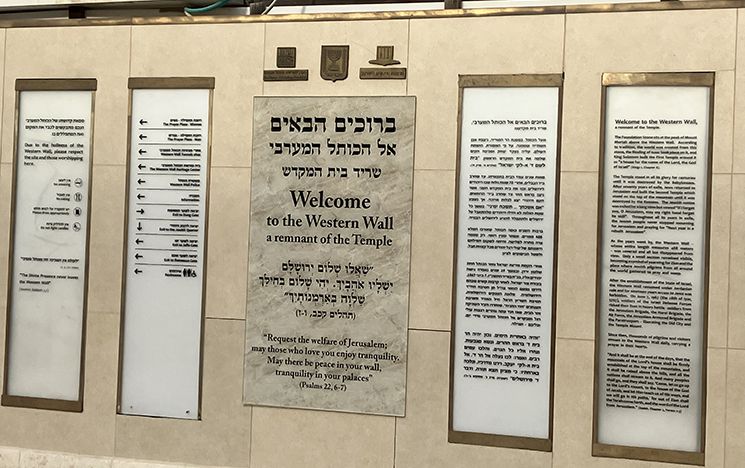
Figure 1: Sign at entrance to Western Wall Plaza, Jerusalem, 2023
The welcome sign at the entrance to the Western Wall Plaza, alongside others, was set up by the Western Wall Heritage Foundation, a body operating under the auspices of the Prime Minister of Israel and the Government Companies Authority. The group is responsible for the upkeep of the Western Wall Plaza area and the various signs are part of an ongoing effort to develop the site and make it more accessible and amenable to the millions of tourists and pilgrims that arrive every year. The Western Wall Plaza was created in 1967, after the demolition of the Mughrabi Quarter, and is adjacent to the actual Western Wall prayer area, also referred to as Kotel (wall). The Western Wall Rabbinate, which is a branch of the Chief Rabbinate of Israel, and hence a strictly orthodox institution, is the religious authority responsible for site.
In 2022, the Israeli cabinet approved the allocation of 110 million Shekel (approximately £23 million) to the Western Wall Heritage Foundation for infrastructural work as well as various educational programmes. Reform and Conservative movements, as well as the Women of the Wall, a group which advocate single sex worship at the Western Wall, soon realised that the approved budget did not allocate any funds for Ezrat Yisrael, the egalitarian prayer platform, at the southern expanse of the Western Wall. Indeed, Ezrat Yisrael has been closed since 2018 when a stone was dislodged and crashed onto the egalitarian prayer area. During the duration of my fieldwork in 2023, the area remained closed and families and groups of people coming to celebrate their child’s Bar Mitzvah or Bat Mitzvah (Jewish coming of age ritual) at Ezrat Yisrael were left upset and disappointed.
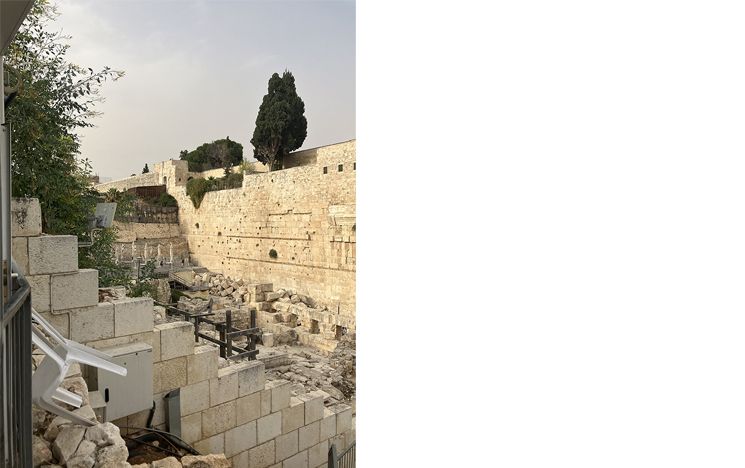
Figure 2: Egalitarian Prayer area, Jerusalem, 2023
Dos and Don’ts at the Western Wall
Visitors to the Western Wall Plaza will also be greeted by various other signs that inform them about the dos and don’ts of good etiquette. In practical terms this means that they should dress modestly and behave respectfully. On occasion, I observed that female visitors wearing shorts or sleeveless tops were stopped and asked to cover up with one of the scarves available at the entrance to the Western Wall Plaza and the prayer area. On Shabbat, an additional portable sign is placed right in front of the Kotel praying area. The prayer area is conceived as an open-air synagogue and according to orthodox tradition partitioned by a mechitzah that keeps men and women apart. More particularly, the sign reminds visitors that mobile phones, cameras, smoking, as well as writing, are off-limits during Shabbat. Interestingly, one of the signs near the entrance also declares that musical instruments are not allowed past the security checkpoint. Thus, musicians employed at the Western Wall Plaza area usually stop their musical processions in front of the large security checkpoint, near the Dung Gate. Yet, some musical instruments appear to be inconspicuous enough to make it past the security checkpoint, i.e. small plastic whistles, although it is not musicians who bring them along.
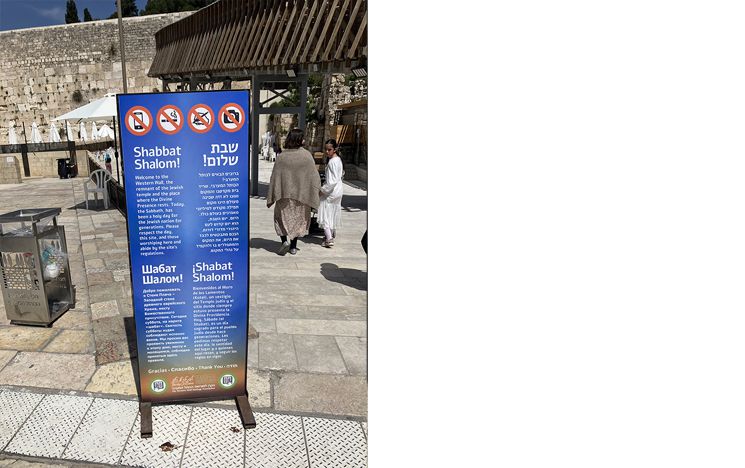
Figure 3: Sign at Western Wall Plaza
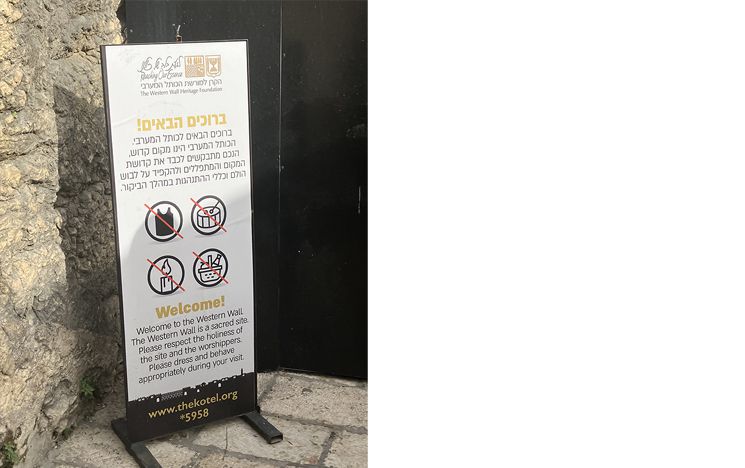
Figure 4: Sign at Western Wall Plaza
Jewish Law has no Issue with Whistling
There is no issue in Jewish Law with whistling. Even on Shabbat, Jews are allowed to whistle as long as they do not use a whistle as this would be seen as playing a musical instrument, which is forbidden on a day of rest. On any other day, whistles are allowed, and some orthodox and Haredi (strictly orthodox) men and women happily make use of the small instruments in their various endeavours to interrupt the egalitarian or single sex services organised by groups of non-orthodox Jews. The clashes in the Western Wall prayer area and the adjacent Western Wall Plaza during Rosh Chodesh prayers have become a recurrent monthly event during which various Jewish groups, including Haredim, as well as young women from religious seminaries, disrupt the single sex service performed by neshot hakotel (Women of the Wall). What they object to is that the women hold autonomous public prayers, wear a tallit (Hebrew: טַלִּית), prayer shawls, bind themselves with tefillin (Hebrew: תְּפִלִּין), phylacteries, and read out loud from the Torah. Significantly, during this ritualised monthly performance, the small plastic whistles, and the ear-piercing noise they produce feature prominently. Arguably, they may also present a nuisance to visitors and participant observers present at the site.
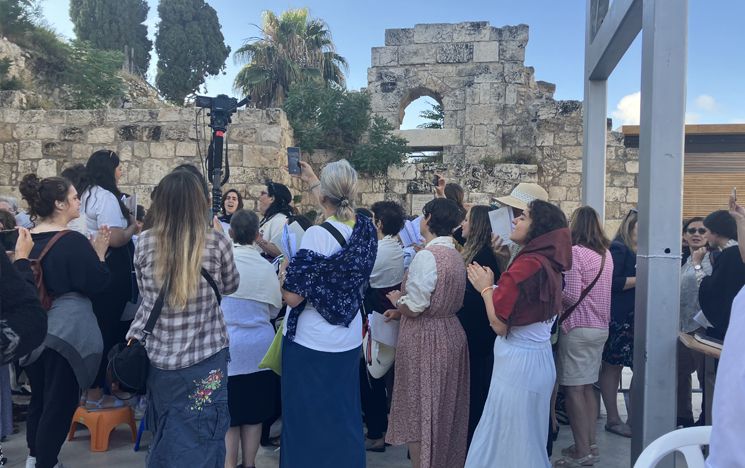 Figure 5: Women of the Wall during Rosh Chodesh prayers, Jerusalem, 2023
Figure 5: Women of the Wall during Rosh Chodesh prayers, Jerusalem, 2023
The Aesthetics of ‘Communitas’ and Internal Strife
While the Women of the Wall group is often associated with Reform Judaism, its members come from various Jewish denominations: Orthodox, Reform, Conservative, Masorti, Renewal and Reconstructionist, both from Israel and abroad. Neshot hakotel have been active since the late 1980s in their struggle to achieve the right for women to wear prayer shawls, sing, pray and read from the Torah collectively and out loud at the Kotel Ha-Ma’aravi (Western Wall). Traditionally, and according to orthodox Judaism, these rights are reserved for Jewish men. While Women of the Wall conduct their single sex service in the women’s section, men on the opposite side of the barrier sometimes appear to turn up the volume during prayers, or even use a megaphone. Not surprisingly, Women of the Wall believe that this is an attempt to drown out their service.
Thus, far from experiencing what anthropologist Victor Turner coined ‘communitas’, a kind of unstructured community in which all people are equal, Jewish pilgrims to the Western wall publicly perform their internal strife in front of Judaism’s holiest place. Anthropologists have widely reported on the often contrasting, and at times conflicting interests of the various social, cultural, political and religious worlds that emerge and transpire at sacred sites. Clearly, Jerusalem’s Western Wall is no exception here, certainly not during Rosh Chodesh prayers. Indeed, rather than experiencing a heightened sense of unity at the pilgrimage site, those present will be drawn into or become spectators to the ‘sonic warfare’ unfolding in front of the Kotel (Western Wall).
Whistling, singing, praying, chanting, booing, heckling, as well as passionate speeches that at times feed into heated debates, all form part of the sonic repertoire that is enhanced by various technologies, such as megaphones and special communication devices used by security forces who try to keep the parties apart. Amidst the sound of whistling, the voices of young Haredi men can be heard. Standing near the entrance to the women’s section, they often shout towards the Women of the Wall group, telling them to ‘go home to Tel Aviv’ or ‘to feel ashamed of themselves.’ Jewish women of various ages are also happy to express their discontent with the Women of the Wall. During one Rosh Chodesh in 2023, an elderly woman, visibly agitated, paced around the group while passionately addressing the orthodox girls and women around her: ‘They (Women of the Wall) think the Kotel is a beach where they can turn up in a swimsuit.’ The woman referred to an actual event where an Israeli woman disrobed in the women’s section of the Western Wall prayer area, apparently in protest of a contentious bill that would criminalize immodest dress at the holy site. As the bubble of voices reaches a crescendo in front of the Western Wall during Rosh Chodesh, the very idea of silent prayer and tranquillity is called into question.
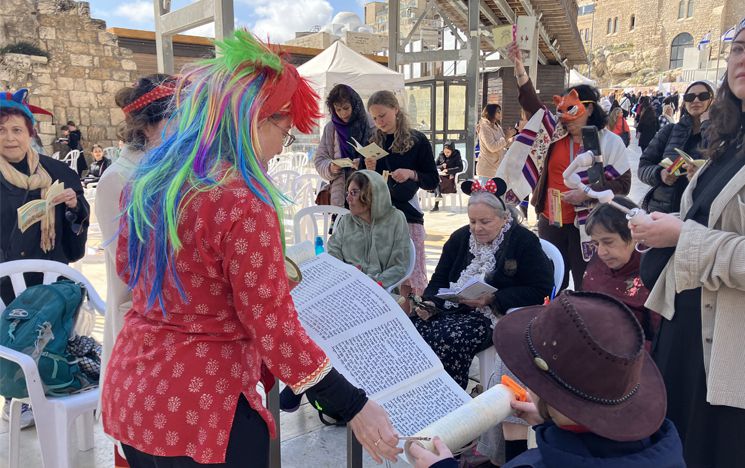 Figure 6: Women of the Wall during Shushan Purim, Jerusalem, 2023
Figure 6: Women of the Wall during Shushan Purim, Jerusalem, 2023
And yet, contestation and discord are only part of what is performed at the Western Wall or in the Jewish Quarter of the Old City. Both pilgrims and non-practicing Jews report that they viscerally experience feelings of unity and cultural belonging when visiting the site. Thus, Jewish visitors to Jerusalem may spontaneously join a group of Jewish men or women dancing in the Western Wall Plaza and experience a profound emotional response to it. Others may be drawn to the soulful songs performed by groups of young men in the Jewish Quarter of the Old City during Tisha B’Av when Jews ritually mourn the destruction of their two ancient temples. Yet others may feel empowered when joining the Women of the Wall during Rosh Chodesh prayers. Thus, contestation and ‘communitas’ may well co-exist in the intermittent spaces that groups of people carve out for themselves. The ‘sonic warfare’ at the Western Wall suggests that the affective force of sound may well play an important part in carving out these spaces.
Despite the fierce opposition on the part of the strictly orthodox management of the Western Wall prayer area and their supporters, the Women of the Wall continue their struggle, encouraged by some Knesset (Israeli parliament) members who may help them with bringing a Torah scroll into the prayer area, as well as by visiting Reform rabbis who boost their morale. Clearly, the ‘sonic warfare’ taking place during Rosh Chodesh is also debated and reflected on by members of various Jewish communities outside Israel. Individual Jews as well as representative organisations, such as the British Board of Jewish Deputies, will make public statements and condemn any violence taking place at the Western Wall. Some visitors and pilgrims will join the Women of the Wall when visiting Jerusalem while others will look at their monthly protest with a critical eye, explaining to their children that ‘this is not the proper Jewish way to pray at the Kotel.’ Indeed, recently thousands of UK orthodox and Haredi Jews came out in support for the campaign against the egalitarian prayer compromise at the Western Wall.
Importantly, the ‘sonic warfare’ at the Western Wall and its repercussions form part of various circuits of exchange between Israel and the UK. These flows include ideas, opinions, emotions, written communications, as well as donations and funding from organisations and interest groups that wish to offer support to either one of the parties. Thus, various individuals and organisations may mobilise religious, social, economic and political resources to promote and facilitate the implementation of their own preferred beliefs and wishes about how the ‘holiness’ of the Western Wall can be achieved, and the way it ought to be encountered and experienced.
Clearly, the sound of whistling, booing, heckling as well as the megaphone-amplified voices may spread a mood of fear and intimidation, as well as emotional upheaval, among supporters of the Women of the Wall group and others present at the site. Yet, the voices of the Women of the Wall seem not prepared to subside into silence.